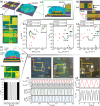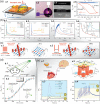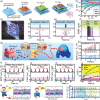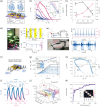Advanced Neuromorphic Applications Enabled by Synaptic Ion-Gating Vertical Transistors
- PMID: 38757653
- PMCID: PMC11251569
- DOI: 10.1002/advs.202305611
Advanced Neuromorphic Applications Enabled by Synaptic Ion-Gating Vertical Transistors
Abstract
Bioinspired synaptic devices have shown great potential in artificial intelligence and neuromorphic electronics. Low energy consumption, multi-modal sensing and recording, and multifunctional integration are critical aspects limiting their applications. Recently, a new synaptic device architecture, the ion-gating vertical transistor (IGVT), has been successfully realized and timely applied to perform brain-like perception, such as artificial vision, touch, taste, and hearing. In this short time, IGVTs have already achieved faster data processing speeds and more promising memory capabilities than many conventional neuromorphic devices, even while operating at lower voltages and consuming less power. This work focuses on the cutting-edge progress of IGVT technology, from outstanding fabrication strategies to the design and realization of low-voltage multi-sensing IGVTs for artificial-synapse applications. The fundamental concepts of artificial synaptic IGVTs, such as signal processing, transduction, plasticity, and multi-stimulus perception are discussed comprehensively. The contribution draws special attention to the development and optimization of multi-modal flexible sensor technologies and presents a roadmap for future high-end theoretical and experimental advancements in neuromorphic research that are mostly achievable by the synaptic IGVTs.
Keywords: artificial synapses; brain‐inspired; electrochemical; field effects; human‐machine interfacing; multi‐modal; sensors.
© 2024 The Authors. Advanced Science published by Wiley‐VCH GmbH.
Conflict of interest statement
The authors declare no conflict of interest.
Figures



















Similar articles
-
Flexible Artificial Sensory Systems Based on Neuromorphic Devices.ACS Nano. 2021 Mar 23;15(3):3875-3899. doi: 10.1021/acsnano.0c10049. Epub 2021 Jan 28. ACS Nano. 2021. PMID: 33507725 Review.
-
Stimuli-Enabled Artificial Synapses for Neuromorphic Perception: Progress and Perspectives.Small. 2020 Aug;16(34):e2001504. doi: 10.1002/smll.202001504. Epub 2020 Jul 30. Small. 2020. PMID: 32734644 Review.
-
Pseudo-transistors for emerging neuromorphic electronics.Sci Technol Adv Mater. 2023 Mar 20;24(1):2180286. doi: 10.1080/14686996.2023.2180286. eCollection 2023. Sci Technol Adv Mater. 2023. PMID: 36970452 Free PMC article. Review.
-
Stretchable Transistor-Structured Artificial Synapses for Neuromorphic Electronics.Small. 2023 May;19(18):e2205395. doi: 10.1002/smll.202205395. Epub 2023 Feb 7. Small. 2023. PMID: 36748849 Review.
-
The Design of 3D-Interface Architecture in an Ultralow-Power, Electrospun Single-Fiber Synaptic Transistor for Neuromorphic Computing.Small. 2020 Apr;16(13):e1907472. doi: 10.1002/smll.201907472. Epub 2020 Feb 18. Small. 2020. PMID: 32068955
Cited by
-
TCAD Simulation of Resistive Switching Devices: Impact of ReRAM Configuration on Neuromorphic Computing.Nanomaterials (Basel). 2024 Nov 21;14(23):1864. doi: 10.3390/nano14231864. Nanomaterials (Basel). 2024. PMID: 39683253 Free PMC article.
-
Recent Advances in Wearable Thermal Devices for Virtual and Augmented Reality.Micromachines (Basel). 2025 Mar 27;16(4):383. doi: 10.3390/mi16040383. Micromachines (Basel). 2025. PMID: 40283260 Free PMC article. Review.
-
Using the Transversal Admittance to Understand Organic Electrochemical Transistors.Adv Sci (Weinh). 2025 Jan;12(3):e2410393. doi: 10.1002/advs.202410393. Epub 2024 Nov 25. Adv Sci (Weinh). 2025. PMID: 39587828 Free PMC article.
-
A Review of Nanowire Devices Applied in Simulating Neuromorphic Computing.Nanomaterials (Basel). 2025 May 11;15(10):724. doi: 10.3390/nano15100724. Nanomaterials (Basel). 2025. PMID: 40423114 Free PMC article. Review.
-
Identification of Risk Loci for Radiotherapy-Induced Tinnitus and Hearing Loss Through Integrated Genomic Analysis.Int J Mol Sci. 2025 Apr 26;26(9):4132. doi: 10.3390/ijms26094132. Int J Mol Sci. 2025. PMID: 40362371 Free PMC article.
References
-
- Santiago R. Y. C., Textura del sistema nervioso del hombre y de los vertebrados, Librerıía de Nicolás Moya, España, Madrid, 1899.
-
- Kandel E. R. in Principles of Neural Science, 5th Ed., McGraw‐Hill, New York, 2013.
-
- Bhunia R., Boahen E. K., Kim D. J., Oh H., Kong Z., Kim D. H., J. Mater. Chem. C 2023, 11, 7485.
Publication types
Grants and funding
LinkOut - more resources
Full Text Sources
